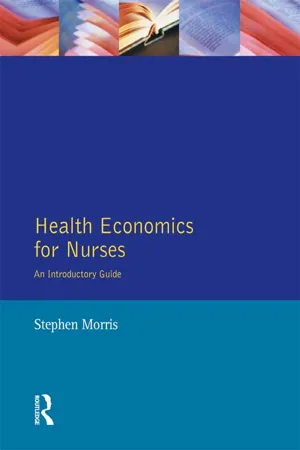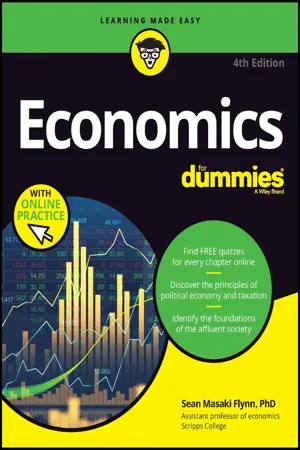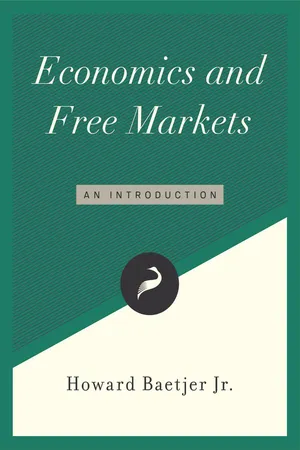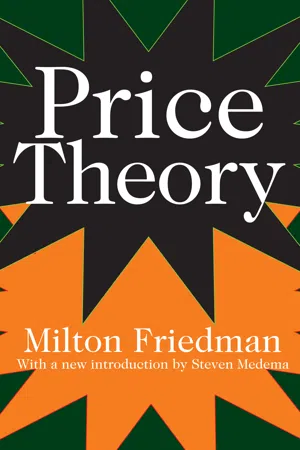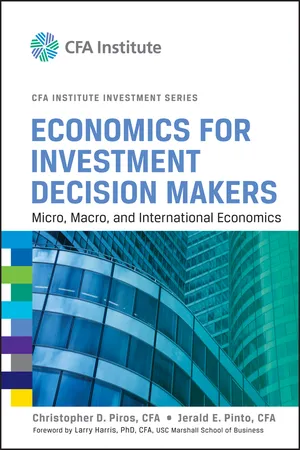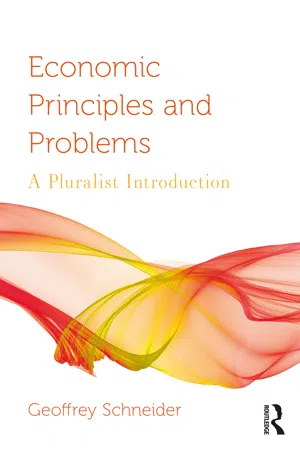Economics
Supply Curve Slope
The supply curve slope represents the relationship between the price of a good or service and the quantity supplied by producers. A positive slope indicates that as the price increases, the quantity supplied also increases, reflecting the law of supply. The slope of the supply curve is influenced by factors such as production costs, technology, and resource availability.
Written by Perlego with AI-assistance
Related key terms
11 Key excerpts on "Supply Curve Slope"
- eBook - ePub
Health Economics For Nurses
Intro Guide
- Stephen Morris(Author)
- 2014(Publication Date)
- Routledge(Publisher)
In a similar fashion to the discussion of demand above, we will first concentrate on the single major influence determining supply: the price of the good itself. All other things being equal, a greater quantity will be supplied at a higher price. In other words, the quantity that a producer will supply is positively associated with the price of the good.The quantity of a good supplied rises when the price of the good rises, and the quantity supplied falls when the price falls. This result has an intuitive appeal for two reasons, which apply first to producers currently supplying the good in question, and secondly to new producers who wish to enter the market and start supplying the good:1. Producers currently supplying the good in the market As price increases, the prospects for making profits are greater and therefore there is a greater incentive for current producers in the market to produce more and offer it for sale. 2. Producers who wish to start supplying the good in the marketAs price increases, producers who could not profitably supply goods at a lower price would find it possible to do so at the higher price. Therefore, as price increases so more producers will enter the market and the quantity supplied will increase.Therefore, as price increases so the quantity supplied will increase for these two reasons. The relationship between price and quantity supplied may be demonstrated graphically, by constructing a supply curve (see Figure 2.4 ).The supply curve shows the quantity supplied at every price. This curve is upward sloping from left to right and it therefore has a positive slope. At a relatively low price such as P3 only a relatively low quantity of the good is supplied, Q3 . If price increases, say to P4 , then the quantity supplied also increases, to Q4 .In the case of the demand curve we were able to derive the downward slope using the theory of diminishing marginal utility, combined with the assumption of utility maximisation. Analogous assumptions may be used to explain the upward-sloping supply curve: increasing marginal cost and profit maximisation. To explain the effects of these concepts, we first need to examine the various costs of production. - eBook - ePub
Economics For Dummies
Book + Chapter Quizzes Online
- Sean Masaki Flynn(Author)
- 2023(Publication Date)
- For Dummies(Publisher)
1 . This result makes good sense because if demand increases and buyers are willing to pay more for something, you would expect more of it to be supplied. Also, the price goes up from one equilibrium to the other because to get suppliers to supply more in a world of rising costs, you have to pay them more.However, a much more subtle thing to realize is that the slope of the supply curve interacts with the demand curve to determine how big the changes in price and quantity will be. Think of a vertical (perfectly inelastic) supply curve, such as the one in the left-hand graph of Figure 4-7 . For such a supply curve, any increase in demand increases only the price because the quantity can’t increase. On the other hand, if you’re dealing with a horizontal (perfectly elastic) supply curve, as in the right-hand graph of Figure 4-7 , a rightward shift in demand increases only the quantity because the price is fixed at P '.Neither demand nor supply is in complete control in a situation like Figure 4-11 . Their interaction jointly determines equilibrium prices and quantities and how they change if the demand curve or the supply curve shifts.Reacting to a decrease in supply
If supply decreases and demand stays the same, the equilibrium price increases, but the equilibrium quantity decreases. Consider Figure 4-12 , where the supply curve shifts fromS0toS1because of increased production costs. (As I discuss in the earlier section “Cost changes: Shifting the supply curve ,” this increase in costs can be considered to shift the supply curve either up or to the left. In Figure 4-12 , I’ve drawn a vertical arrow to indicate a vertical shift, but I could’ve just as correctly put in a left arrow to show a leftward shift.)The shift in supply causes the market equilibrium to adjust. The original equilibrium is at priceP* 0and quantityQ* 0 ,which is the point where the demand curve D and the initial supply curveS0cross. When production costs increase, the supply curve shifts toS1 - D.R. Kiran(Author)
- 2022(Publication Date)
- Butterworth-Heinemann(Publisher)
Value in exchange, expressed in terms of money, is called the price. As seen in the previous section, the price is very much related to the value in exchange. When a quintal of rice is exchanged against money, the ratio of one quintal of rice with the money units is known as price. In actual life, all transactions are usually conducted in terms of money.5.5: Concepts of pricing
While Chapter 11 discusses several costs involved and the methodology for fixing the price of a commodity price based on the cost of production, this section indicates some of the features and terminology used in understanding the combined effect of laws of demand and supply on the equilibrium price, from the economic theory point of view:- 1. The demand curve slopes downward to the right, indicating that, as price rises, a lower quantity will be demanded, and as price falls, a higher quantity will be demanded.
- 2. The Supply Curve Slopes upward to the right showing that, as price rises, a larger quantity will be supplied and, as price falls, a lower quantity will be supplied.
- 3. A change in price will only cause a movement along the demand and supply curves and will not cause either of these curves to shift.
- 4. Among the economic variables that will shift the demand curve are changes in tastes, incomes, expectations, prices of other goods, and the number of buyers.
- 5. Among the economic variables that will shift the supply curve are changes in costs, expectations, and the number of sellers.
- 6. Changes in the equilibrium price and quantity will occur when the demand and/or supply curves shift. These changes can be summarized as follows:
- (i) An increase in demand yields a price increase and a quantity increase.
- (ii) A decrease in demand yields a price decrease and quantity decrease.
- (iii) An increase in supply yields a price decrease and a quantity increase.
- (iv) A decrease in supply yields a price increase and a quantity.
5.6: Equilibrium price
In the previous chapter, we saw how the laws of demand and supply have their impact on the pricing structure. Fig. 5.1 clarifies the combined effect of these two laws on the prices. As the price increases, the demand from the customer’s side would reduce, but the producers would be motivated to produce more and supply more to get higher income. In a competitive market, such a situation would stabilize the price and the supply would be same as the demand, as shown by X in Fig. 5.2- eBook - ePub
Economics and Free Markets
A Reader
- Howard Baetjer(Author)
- 2017(Publication Date)
- Cato Institute(Publisher)
This arrangement we call a supply “curve.” Notice how it reflects the law of supply: at higher prices, more corn would be offered for sale. Almost never will a supply curve identify the supplier of each quantity of a good by name, as here; almost always, the supply curves we’ll consider represent too many suppliers to name in a smoothly upward-sloping line. We present supply this way as we introduce it to emphasize that every point on a supply curve always represents some particular person (or company) willing to accept some particular amount (or more, but not less) for an additional quantity of the good or service.The Information a Supply Curve ProvidesSimilar to a demand curve, a supply curve gives us quantity information about costs and cost information about quantities. For example, what does the supply curve for corn in Figure 6.1 tell us about a seller cost of $6 per bushel? It tells us that in this market, 700 bushels can be offered at a cost of $6 per bushel or less. In other words, it tells us that at a price of $6 per bushel, the quantity supplied would be 700 bushels. At a seller cost of $5 or less, only 500 bushels can be produced, so at a price of $5 per bushel, only 500 would be supplied.To generalize, a supply curve tells us the quantity supplied at any given price or cost, the quantity that suppliers in that market would be willing and able to sell at that price.What does a supply curve tell us about any quantity that might be brought to market? It tells us the cost of doing so. For example, what is the cost of offering, say, the 800th bushel of corn in our imaginary market? Trace upward from 800 on the quantity axis until you reach the supply curve. You reach it at the $7 level. Hence, the cost of producing that 800th bushel—to Jonas, in the example—is $7’s worth of his land, time, and fertilizer. What’s the cost of producing the 1,000th bushel? It’s $9: the $9’s worth of Hiram’s time, fertilizer, irrigation, and land needed to produce it.Here’s a good time for a reminder about the meaning of cost. All costs are best understood as opportunity costs. The cost of producing that 1,000th bushel is the value of the most valuable good(s) that could have been produced instead, using the farmer’s time, fertilizer, irrigation, and land that he uses to produce that bushel of corn. To generalize, a supply curve tells us the marginal cost—the cost to its seller of providing each additional unit of the good for sale. - eBook - ePub
- Milton Friedman(Author)
- 2017(Publication Date)
- Routledge(Publisher)
5The Relationships Between Supply Curves and Cost CurvesThe Definition of a Supply Curve
Consider a two-dimensional graph in which the quantity of a commodity per unit time is measured along the horizontal axis and price per unit of the commodity is measured along the vertical axis (Figure 5.1 ). Each point on this graph denotes a combination of a price and a quantity. For a specific group of suppliers (which may as a special case consist of a single firm), a specific commodity, and given conditions of supply (to be defined more explicitly below), some of these points will be attainable in the sense that the suppliers would be willing to supply the indicated quantity at the indicated price, whereas others will be unattainable in the sense that the suppliers would not be willing to supply the indicated quantity at the indicated price. The supply curve of the specific group for the specific commodity is the boundary line between those points that are and those that are not attainable under the given conditions of supply.For a full description, the supply curve must be accompanied by a specification of (a) the alternatives considered open to the suppliers and (b) which of the two areas into which the supply curve divides the space contains the attainable points.As an example of the meaning of (a), the supply curve will be one thing if the suppliers are considered as having the alternative of supplying either the indicated quantity at the indicated price or nothing at all; it will be quite different if they are considered as having the alternative of supplying either the indicated quantity or any smaller quantity at the indicated price. In general, we shall suppose the latter to be the alternative open to suppliers.FIGURE 5.1The relevance of (b) is exemplified in Figure 5.1 , in which the shaded areas designate the attainable points. The supply curve in Figure 5.1 (a) can be described in either of two ways: as showing the maximum quantity that would be supplied at a specified price or as showing the minimum price at which a specified quantity would be supplied. The supply curve in Figure 5.1 (b) can be described in only one of these ways: as showing the maximum quantity that would be supplied at a specified price. The supply curve in Figure 5.1 (c) shows only the minimum price at which a specified quantity would be supplied. The negatively sloped portion of a supply curve like that in Figure 5.1 (b) is frequently referred to as a “backward-bending” supply curve; a supply curve like that in Figure 5.1 (c) is referred to as a “forward-falling” supply curve. The segment of a supply curve in Figure 5.1 - No longer available |Learn more
Contemporary Economics
An Applications Approach
- Robert Carbaugh(Author)
- 2016(Publication Date)
- Routledge(Publisher)
- A market is a mechanism through which buyers and sellers communicate in order to trade goods and services. Through the price system, markets link potential buyers with potential sellers.
- Demand is a schedule that shows the amount of a good or service that buyers are willing and able to purchase at each possible price during a particular period. A demand curve is a graphical representation of the data comprised by a demand schedule. A movement along a demand curve, resulting from a change in price, is called a change in quantity demanded.
- According to the law of demand, price and quantity demanded are inversely related, assuming that all other factors affecting the quantity demanded remain the same. Economists explain the law of demand in terms of the substitution effect, the income effect, and the principle of diminishing marginal utility.
- A demand shifter is a variable that causes a shift in a demand curve. Among the most important demand shifters are consumer tastes, the number of buyers, consumer income, the prices of related goods, and expected future prices. When a demand shifter causes an increase in demand, the demand curve shifts to the right; a decrease in demand causes the demand curve to shift to the left.
- Supply is a schedule or curve showing the amounts of a good or service that firms or households are willing and able to sell at various prices during a particular period. The quantity supplied refers to a single point on a supply curve. Changes in quantity supplied are caused by changes in the price of the product.
- According to the law of supply, sellers are willing and able to make more of their product available at a higher price than a lower price, all other determinants of supply being constant. The tendency for the cost of additional output to increase explains the law of supply.
- A supply shifter is a variable that causes a shift in a supply curve. Among the major supply shifters are resource prices, technology, the prices of other goods, expected future prices, taxes and subsidies, and the number of suppliers. When a supply shifter results in an increase in supply, the supply curve shifts to the right; a decrease in supply shifts the supply curve to the left.
- eBook - ePub
Microeconomic Principles and Problems
A Pluralist Introduction
- Geoffrey Schneider(Author)
- 2024(Publication Date)
- Routledge(Publisher)
SUVs–Gas = −0.3. Similarly, meat and potatoes are complements for many consumers, with a cross-price elasticity of −0.2.We also find goods that are neither substitutes nor complements for each other, in which case the cross-price elasticity is 0. The price of Coca-Cola has no impact on the demand for iPhones, so eCoke-iPhones = 0.Now that we have studied how elasticities affect the demand curve, we can move onto the price elasticity of supply, which helps us determine when supply curves are elastic or inelastic.10.8 PRICE ELASTICITY OF SUPPLY
The price elasticity of supply measures the responsiveness of quantity supplied to changes in price. In mathematical terms, the price elasticity of supply, eS , is equal to the percentage change in the quantity supplied divided by the percentage change in price. The price elasticity of supply is greater than or equal to zero, eS ≥ 0, because of the positive slope of the supply curve. The formula for the price elasticity of supply, eS , is:e S==▵ QQ 1▵ PP 1.(Q 2−Q 1)Q 1(P 2−P 1)P 1Price elastic and price inelastic supply curves.FIGURE 10.18The formula for the price elasticity of supply is the same as the formula for the price elasticity of demand, but we use two points along the supply curve to compute it. For example, in Figure 10.18(a) we see an elastic supply curve for hamburgers. The supply of hamburgers is elastic because there is a large amount of frozen hamburgers available in storage, so suppliers can get more hamburgers very easily in the short run if demand increases. In Figure 10.18(a) , the demand for hamburgers increases, shifting to the right from D1 to D2 - eBook - ePub
Potatoes
Production, Marketing, And Programs For Developing Countries
- Douglas Horton(Author)
- 2019(Publication Date)
- CRC Press(Publisher)
Fig. 7 ). When supply and demand curves are plotted on the same scale, their point of intersection marks the equilibrium price at which the amount offered for sale is equal to the amount that will be purchased.Figure 7 . Supply and demand curves, showing the market equilibrium price (P) and quantity (Q).The principles of supply and demand apply in both market economies and centrally planned economies. When governments fix prices, signs that the government-mandated price is below the market equilibrium level are shortages, rationing, and long lines of would-be customers standing outside food stores. Stockpiled surpluses, on the other hand, indicate that prices are above the equilibrium level.Supply
Over time, the supply curve for potatoes may shift in response to a variety of changes: in the prices of inputs used in potato production; in the production technology employed by farmers; in the supply of land, labor, and capital; and in environmental conditions. If input prices increase, for example, the supply curve will shift upward and to the left (from SI to S2 in Fig. 8 ). Producers will supply fewer potatoes to the market (Q2 rather than Ql), and prices will rise (from PI to P2). On the other hand, if input prices fall, the supply curve will shift downward and to the right (from SI to S3). Farmers will supply more potatoes (Q3 rather than Ql), and prices will fall (from PI to P3). If farmers begin to use new technologies that enhance the productivity of inputs, the supply curve will shift to the right, enlarging market supplies and reducing prices.Figure 8 . Effects of a shift in the supply curve on the price and quantity of potatoes supplied and demanded.In the short run, the supplies of many factors of production, such as land, equipment, and labor are fixed; but over time they can also change. Changes in the amount of land, labor, and capital devoted to potato production will affect the supply of potatoes, and vice versa. - eBook - ePub
Economics for Investment Decision Makers
Micro, Macro, and International Economics
- Christopher D. Piros, Jerald E. Pinto(Authors)
- 2013(Publication Date)
- Wiley(Publisher)
Q . Note that the price intercept is 90, and the quantity intercept is 180. Draw the demand curve:Find the area of the triangle above the price and below the demand curve, up to quantity 50. Area of a triangle is given as ½ Base × Height = (½)(50)(25) = 625.3.10. Producer Surplus—Revenue minus Variable Cost
In this section, we discuss a concept analogous to consumer surplus called producer surplus . It is the difference between the total revenue sellers receive from selling a given amount of a good, on the one hand, and the total variable cost of producing that amount, on the other hand. Variable costs are those costs that change when the level of output changes. Total revenue is simply the total quantity sold multiplied by the price per unit.The total variable cost (variable cost per unit times units produced) is measured by the area beneath the supply curve, and it is a little more complicated to understand. Recall that the supply curve represents the lowest price that sellers would be willing to accept for each additional unit of a good. In general, that amount is the cost of producing that next unit, called marginal cost . Clearly, a seller would never intend to sell a unit of a good for a price lower than its marginal cost, because the seller would lose money on that unit. Alternatively, a producer should be more than willing to sell that unit for a price that is higher than its marginal cost, because it would contribute something toward fixed cost and profit, and obviously the higher the price the better for the seller. Hence, we can interpret the marginal cost curve as the lowest price sellers would accept for each quantity, which basically means that the marginal cost curve is the supply curve of any competitive seller. The market supply curve is simply the aggregation of all sellers’ individual supply curves, as we showed in section 3.5.Marginal cost curves are likely to have positive slopes. (It is the logical result of the law of diminishing marginal product, which will be discussed in a later chapter.) In Exhibit 1-13 , we see such a supply curve. Because its height is the marginal cost of each additional unit, the total variable cost of Q 1 units is measured as the area beneath the supply curve, up to and including that Q 1 th unit, or the area of the vertically lined trapezoid. But each unit is being sold at the same price P 1 , so total revenue to sellers is the rectangle whose height is P 1 and base is total quantity Q 1 - David Reisman(Author)
- 2013(Publication Date)
- Routledge(Publisher)
Whatever the source of the supply, however, the rule is typically a simple one: when ‘sellers receive more than is sufficient’, then ‘there is at work an active force tending to increase the amount brought forward for sale’. 9 Assuming, of course, ceteris paribus ; for the supply curve, similar in this respect to the demand curve, is free to shift its position or alter its slope in response to changes in technology, transport, the opening up of a new source of supply, the introduction of a tax or a bounty, or any other disturbance or shock to the existing supply price/quantity supplied schedule. Such disturbances or shocks are no problem so long as our analysis is static. The very action of adjustment to stimulus, however, is itself not static but dynamic- eBook - ePub
Economic Principles and Problems
A Pluralist Introduction
- Geoffrey Schneider(Author)
- 2021(Publication Date)
- Routledge(Publisher)
If a firm can maintain a large inventory and if it has access to rapid and inexpensive shipping, it will tend to have an elastic supply curve. Such a firm would be able to increase the quantity of goods offered for sale quickly and easily in response to changes in prices. This has been one of the keys to Amazon’s success. When the demand for a product they are selling increases, they can quickly increase the quantity of the good they offer for sale out of their vast system of warehouses and their inexpensive shipping network. However, a producer with no significant inventory will not be able to increase the quantity supplied quickly when the price increases.10.8.3 Time
As producers have more time to adjust, their supply curve becomes more elastic. A dairy farmer producing milk cannot increase the supply of milk much this year if the price of milk increases. But if milk prices stay high, they can buy or breed more cows, build new barns, grow more cattle feed, and increase their quantity of milk supplied substantially within two years. In general, supply curves tend to be more inelastic in the short run than they are in the long run.Overall, the price elasticity of supply depends on how easy it is for a producer to expand operations. If their size of operations is relatively fixed, they will have an inelastic supply curve. If they can easily and inexpensively increase the amount they supply, they will have a more elastic supply curve.10.9 Conclusion
In this chapter we have refined and extended our understanding of the supply and demand model. We began by analyzing the two factors that cause both the supply curve and the demand curve to shift: Wages and advertising. An increase in wages or advertising causes an increase in demand and a decrease in supply.We then explored government interventions in the marketplace. The installation of price ceilings or price floors does not shift either the supply or the demand curve. Instead, you move along both curves to determine the shortage or surplus that the policy creates. Excise taxes shift the supply curve up by the amount of the tax, and per unit subsidies shift the supply curve down by the amount of the subsidy. All of these government interventions tend to cause reductions in consumer and producer surplus and create deadweight loss that must be weighed against the benefits of the government policy.We also explored elasticity in some detail. There are five different possibilities for the price elasticity of demande d=% ΔQ d% Δ P
Index pages curate the most relevant extracts from our library of academic textbooks. They’ve been created using an in-house natural language model (NLM), each adding context and meaning to key research topics.
